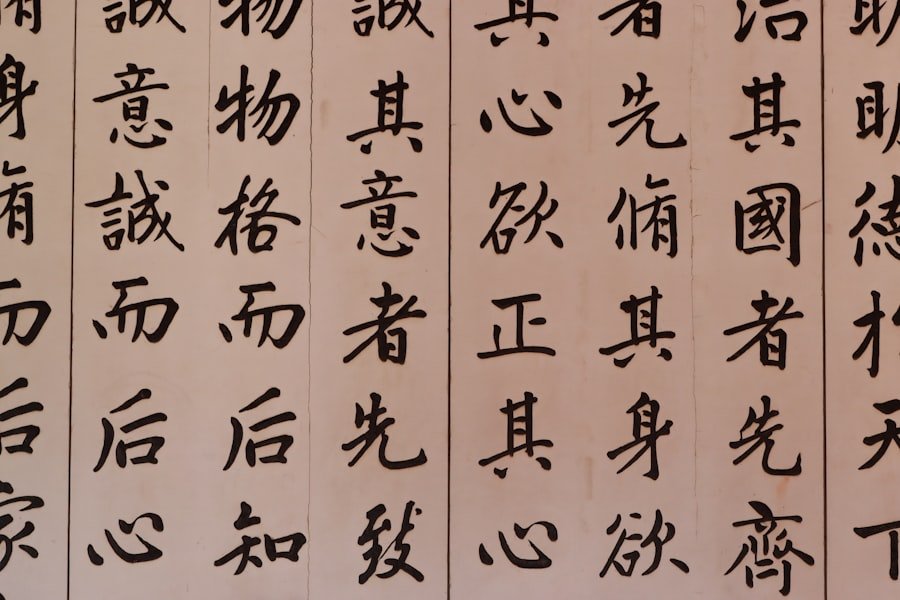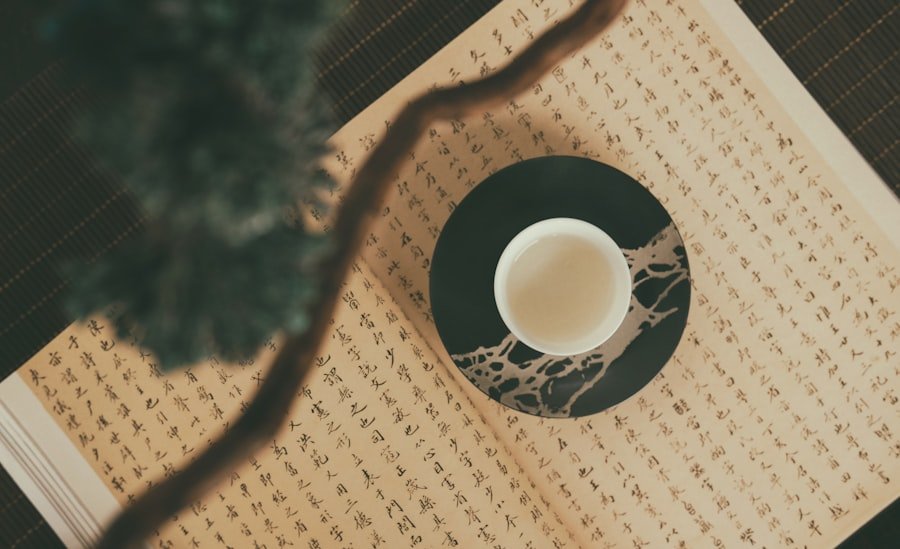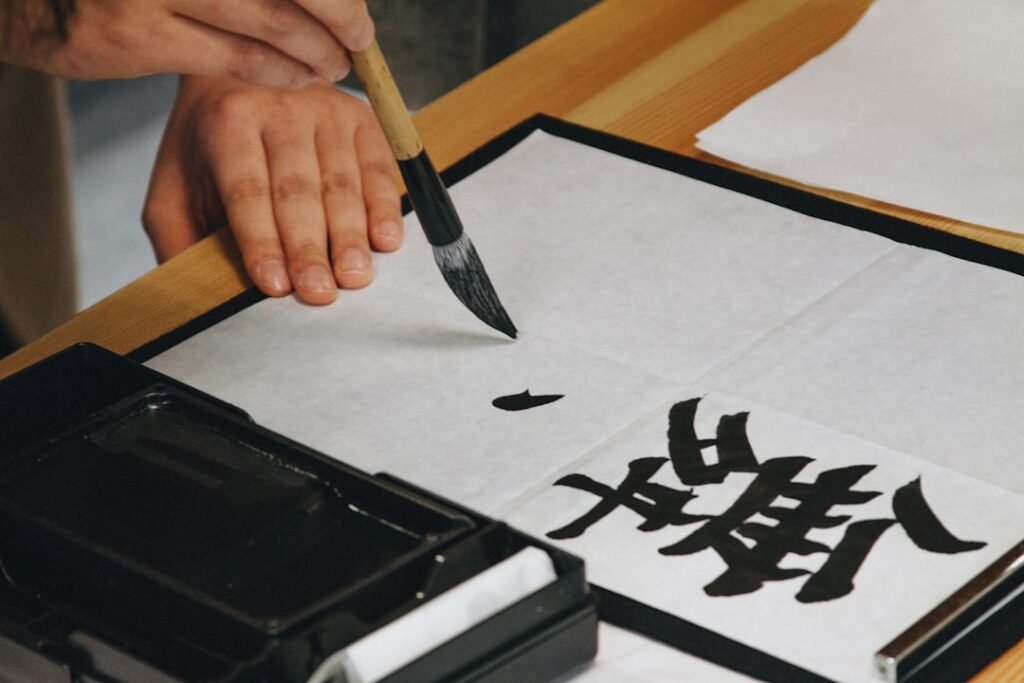Chinese calligraphy is an ancient art form that transcends mere writing; it is a profound expression of culture, philosophy, and aesthetics. Among the myriad techniques and styles that have emerged over centuries, Yong (永字八法), or the “Eight Principles of Yong,” stands out as a foundational element in the study of Chinese calligraphy. The character “Yong” (永), meaning “eternity,” serves as a perfect embodiment of the art’s enduring nature.
This character is not only significant in its meaning but also in its structure, as it encapsulates the essence of calligraphy through its strokes. The practice of Yong is essential for anyone wishing to delve into the world of Chinese calligraphy. It provides a comprehensive framework for understanding the fundamental strokes that form the basis of more complex characters.
By mastering Yong, students can develop their skills in brush control, balance, and aesthetics, which are crucial for creating beautiful calligraphic works. The character itself is composed of eight distinct strokes, each representing a different technique and approach to brushwork. As such, Yong serves as both a practical exercise and a philosophical journey into the heart of Chinese artistic tradition. Master the art of Chinese calligraphy. Enroll now at the LC Chinese School in Oslo.
Table of Contents
ToggleSummary
- Yong (永字八法) Chinese Calligraphy is a traditional art form that focuses on the eight fundamental strokes of the Chinese character “永” (yǒng).
- Understanding the historical significance of Yong (永字八法) provides insight into the cultural and artistic heritage of Chinese calligraphy.
- The eight fundamental strokes of Yong (永字八法) include horizontal, vertical, dot, hook, rising, falling, left-falling, and right-falling strokes.
- Brush techniques used in Yong (永字八法) emphasise control, precision, and fluidity to create balanced and symmetrical characters.
- Balance and symmetry are crucial in Yong (永字八法) to achieve harmony and elegance in Chinese calligraphy.
Understanding the Historical Significance of Yong (永字八法)
The historical significance of Yong (永字八法) cannot be overstated. This character has been revered in Chinese culture for centuries, not only as a symbol of eternity but also as a pedagogical tool for aspiring calligraphers. Its origins can be traced back to ancient China, where scholars and artists recognised the importance of mastering basic strokes as a means to achieve proficiency in calligraphy.
The character Yong has been used in various texts and teachings throughout history, solidifying its status as a cornerstone of calligraphic education. In addition to its educational value, Yong has also played a role in the broader cultural context of China. The character embodies the philosophical ideals of harmony and balance, which are central to Chinese thought.
By practising Yong, calligraphers engage with these concepts on a deeper level, allowing them to connect with the rich tapestry of Chinese history and culture. The character has been celebrated in poetry, literature, and art, further cementing its place as a symbol of artistic excellence and cultural heritage.
The Eight Fundamental Strokes of Yong (永字八法)

At the heart of Yong (永字八法) are the eight fundamental strokes that form the character itself. Each stroke is unique and serves as a building block for other characters in the Chinese language. The first stroke, known as the “dot” (点), is a simple yet essential element that introduces the concept of brush pressure and control.
The second stroke, the “horizontal line” (横), teaches students about fluidity and movement across the page. As one progresses through the strokes, they encounter the “vertical line” (竖), which emphasises stability and strength. The “left-falling stroke” (撇) and “right-falling stroke” (捺) introduce diagonal movements that add dynamism to the writing.
The “hook” (钩) and “turn” (转) strokes further enhance complexity, allowing for greater expression in calligraphy. Finally, the “cross” stroke (交) ties all these elements together, demonstrating how they can coexist harmoniously within a single character. Understanding these eight strokes is crucial for any student of calligraphy.
They not only provide a foundation for writing other characters but also serve as a means to explore individual style and expression. Each stroke carries its own significance and requires dedicated practice to master, making Yong an invaluable tool for both beginners and experienced calligraphers alike.
Exploring the Brush Techniques Used in Yong (永字八法)
The brush techniques employed in Yong (永字八法) are integral to achieving mastery in Chinese calligraphy. Each stroke demands a unique approach to brushwork, requiring practitioners to develop their skills in various techniques such as pressure control, angle adjustment, and speed modulation. The use of a traditional Chinese brush, with its flexible bristles and tapered tip, allows for a range of expressive possibilities that are essential for creating beautiful characters.
One key technique involves varying the pressure applied to the brush during each stroke. For instance, applying more pressure at the beginning of a stroke can create a bold line, while easing off towards the end can produce a delicate tapering effect. This interplay between pressure and release is vital for achieving the fluidity and grace that characterise high-quality calligraphy.
Additionally, understanding how to manipulate the angle of the brush can lead to different line qualities, further enhancing the visual impact of each stroke. Practising these techniques within the context of Yong allows students to experiment with their brushwork while developing their own unique style. As they become more comfortable with these methods, they can begin to incorporate them into their broader calligraphic practice, enriching their overall artistic expression.
The Importance of Balance and Symmetry in Yong (永字八法)
Balance and symmetry are fundamental principles in Chinese calligraphy, particularly when working with Yong (永字八法). The character itself is designed with an inherent sense of balance; each stroke contributes to an overall harmony that is visually pleasing to the eye. Achieving this balance requires careful consideration of spacing, proportion, and alignment within each character.
When practising Yong, students must pay close attention to how each stroke interacts with others. For example, the placement of the horizontal line must complement the vertical line to create a sense of equilibrium within the character. This attention to detail not only enhances the aesthetic quality of the work but also reflects the calligrapher’s understanding of traditional principles that have been passed down through generations.
Moreover, balance extends beyond individual characters; it encompasses entire compositions as well. Calligraphers often consider how multiple characters interact on a page, ensuring that their arrangement creates a cohesive visual narrative. By mastering balance and symmetry through Yong, students can elevate their calligraphic practice and create works that resonate with beauty and elegance.
Mastering the Art of Control and Precision in Yong (永字八法)

Control and precision are paramount in achieving excellence in Yong (永字八法). The nature of calligraphy demands that practitioners develop a keen sense of awareness regarding their brush movements and techniques. Each stroke must be executed with intention and care; even slight deviations can alter the character’s overall appearance and meaning.
To cultivate this level of control, students are encouraged to engage in repetitive practice focused on each individual stroke within Yong. This method allows them to refine their technique gradually while building muscle memory that will serve them well in future calligraphic endeavours. As they become more adept at controlling their brush movements, they will find themselves able to express their artistic vision with greater clarity and confidence.
Additionally, precision is not solely about technical skill; it also involves an understanding of how each stroke contributes to the character’s overall form. Calligraphers must develop an eye for detail, recognising how subtle variations in line thickness or curvature can impact the final result. By honing their control and precision through Yong practice, students will be better equipped to tackle more complex characters and styles in their calligraphic journey.
The Role of Pressure and Speed in Yong (永字八法) Strokes
The interplay between pressure and speed is a critical aspect of mastering Yong (永字八法). Each stroke requires careful modulation of both elements to achieve the desired effect. For instance, applying varying levels of pressure can create different line qualities—thicker lines may convey strength or boldness, while lighter lines can evoke delicacy or grace.
Speed also plays an essential role in shaping each stroke’s character. A swift movement may result in fluid lines that convey energy and dynamism, while slower strokes allow for greater precision and control. Understanding how to balance these two factors is crucial for creating harmonious compositions that resonate with viewers.
Practising Yong provides students with ample opportunities to experiment with pressure and speed variations within each stroke. As they become more attuned to these dynamics, they will develop a deeper understanding of how they can manipulate their brushwork to achieve specific artistic effects. This knowledge will ultimately enhance their overall calligraphic practice and enable them to express their unique style more effectively.
Learning the Different Variations and Styles of Yong (永字八法)
While Yong (永字八法) serves as a foundational exercise in Chinese calligraphy, it also opens doors to exploring various styles and variations within this art form. As students become proficient in executing the eight fundamental strokes, they may begin to experiment with different styles such as regular script (楷书), running script (行书), or cursive script (草书). Each style offers its own unique aesthetic qualities and challenges.
For instance, regular script emphasises clarity and precision, making it ideal for formal documents or inscriptions. In contrast, running script allows for greater fluidity and expressiveness while maintaining legibility. Cursive script takes this expressiveness even further, prioritising speed and spontaneity over strict adherence to form.
By practising Yong within these different styles, students can gain insight into how each approach influences their brushwork and overall artistic expression. Moreover, exploring variations within Yong itself can lead to exciting discoveries about personal style. Calligraphers may choose to emphasise certain strokes or experiment with spacing and composition to create unique interpretations of the character.
This exploration fosters creativity and encourages students to develop their own voice within the rich tradition of Chinese calligraphy.
The Influence of Yong (永字八法) on Chinese Calligraphy and Art
The influence of Yong (永字八法) extends far beyond its role as a foundational exercise; it has shaped the landscape of Chinese calligraphy and art throughout history. Many renowned calligraphers have cited Yong as an essential part of their training, recognising its significance in developing both technical skill and artistic sensibility. As such, it has become synonymous with excellence in calligraphy.
Moreover, Yong’s impact can be seen across various artistic disciplines within Chinese culture. Its principles have informed painting techniques, poetry composition, and even philosophy—demonstrating how deeply intertwined these elements are within Chinese tradition. The character’s emphasis on balance, harmony, and precision resonates throughout artistic practices, making it a vital touchstone for artists seeking to connect with their cultural heritage.
As contemporary artists continue to explore new avenues within Chinese calligraphy, Yong remains a relevant source of inspiration. Its timeless qualities serve as a reminder of the enduring beauty found within simplicity—a lesson that resonates across generations.
Tips for Practicing and Improving Your Yong (永字八法) Skills
For those eager to improve their skills in Yong (永字八法), several practical tips can enhance their practice experience. First and foremost is consistency; regular practice is essential for developing muscle memory and refining technique over time. Setting aside dedicated time each day or week for focused practice will yield significant improvements.
Additionally, seeking feedback from experienced practitioners or instructors can provide valuable insights into areas for growth. Constructive criticism can help identify specific aspects that may require further attention or refinement—whether it be stroke execution or overall composition. Utilising resources such as instructional books or online tutorials can also aid in understanding various techniques associated with Yong practice.
Observing demonstrations by skilled calligraphers can offer inspiration while providing practical guidance on brushwork methods. Finally, embracing patience is crucial; mastery takes time and dedication. Celebrating small victories along the way will foster motivation while reinforcing commitment to this beautiful art form.
Embracing the Beauty and Elegance of Yong (永字八法) in Chinese Calligraphy
In conclusion, Yong (永字八法) represents not only an essential component of Chinese calligraphy but also an invitation to explore beauty through artistic expression. Its historical significance underscores its role as a foundational exercise that has shaped generations of calligraphers while fostering connections between culture and creativity. As students engage with this character’s eight fundamental strokes—mastering techniques related to control, pressure, speed—and embracing principles such as balance—they embark on a journey that transcends mere writing; they delve into an art form steeped in tradition yet alive with contemporary relevance.
For those interested in deepening their understanding of this exquisite art form, consider enrolling in Chinese calligraphy courses at LC Chinese School in Oslo. These courses offer expert instruction tailored to all skill levels—from beginners eager to learn about Yong’s foundational principles to advanced practitioners seeking refinement in their technique. Embrace this opportunity to connect with fellow enthusiasts while immersing yourself in the elegance and beauty that define Chinese calligraphy through Yong (永字八法).
Master the art of Chinese calligraphy. Enroll now at the LC Chinese School in Oslo.







